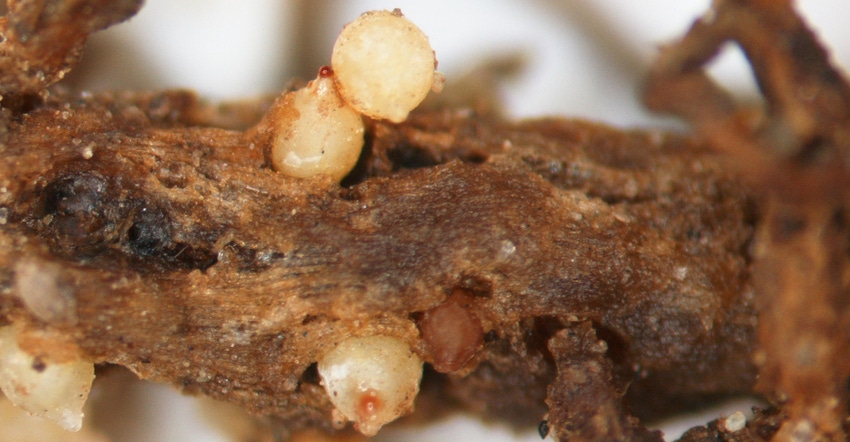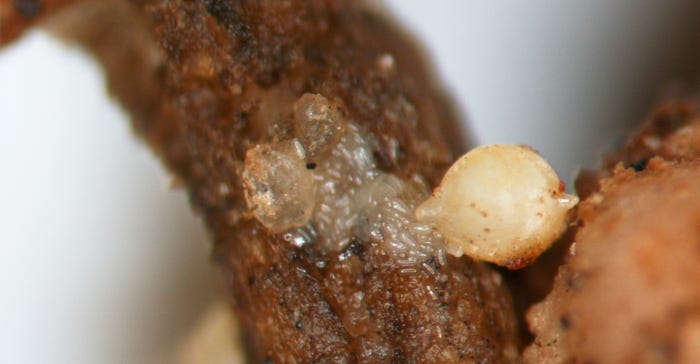January 11, 2018

By Marisol Quintanilla, Kristin Poley, Jeff Shoemaker and Fred Warner
The soybean cyst nematode is a sedentary endoparasite that was first detected in Michigan in 1987 and has since spread. SCN is considered the most destructive soybean pathogen, reducing the number of pods per plant and beans per pod, often resulting in yield reductions of 5% to 30%. Soybeans planted in highly infested fields can experience up to 80% yield loss if susceptible varieties are used.
In Michigan, SCN is known to exist in soybean-producing counties south of Clare County. As more soybeans are being grown in northern Michigan, growers should monitor their fields closely.
SCN is easier to manage if detected early. Once it has infected a field, juvenile SCN will seek out and penetrate soybean roots, causing a feeding site to develop. Females will continue to feed from this site until adulthood, and will release eggs in a jelly-like substance during this time.
When the female dies her body becomes a lemon-shaped protective case for her eggs. This cyst can remain in the soil up to 10 years until a host stimulates the release of juveniles from the eggs within. A single female can produce as many as 200 eggs per cyst. The life cycle of SCN can be completed in as little as 30 days, allowing for multiple generations per growing season.
 DESTRUCTION: The SCN is an endoparasite that can reproduce multiple generations in a single growing season and can cause 80% losses in susceptible varieties.
DESTRUCTION: The SCN is an endoparasite that can reproduce multiple generations in a single growing season and can cause 80% losses in susceptible varieties.

Aboveground symptoms such as stunted and yellowed plants are not unique to SCN and are often overlooked or attributed to other causes, such as nutrient deficiencies. SCN is usually not evenly distributed in the soil, which can further impede detection.
The most accurate way to diagnose an infestation is through identification of juveniles and cysts from a soil or root sample. The Michigan Soybean Promotion Committee provides support for growers to submit samples for identification. Samples should be submitted to the MSU Diagnostics Laboratory.
In addition to regular soil testing, management practices that are typically recommended for SCN-infested fields include planting resistant varieties, rotating sources of resistance, rotating with non-host crops, controlling weeds, and maintaining clean farm equipment to avoid further spread. However, there are limitations to these strategies.
Research suggests that SCN is able to reproduce on resistant varieties due to the extensive use of the PI88788 source of resistance. Rotating sources of resistance and keeping SCN numbers low in the field is recommended to maintain effectiveness of our currently used resistant varieties. Crops in rotation with soybeans must be carefully chosen to ensure they are not also hosts of SCN. Because of this, other legumes, such as hairy vetch, field pea, red clover, etc., should be avoided.
Certain weed species can also be hosts of SCN, so weed management programs should be implemented. See more information about these programs online.
Additional information regarding management of SCN can be found in the North Central Soybean Research Program Soybean Cyst Nematode Management Guide.
Quintanilla, Poley, Shoemaker and Warner are in the MSU Applied Nematology lab
You May Also Like




